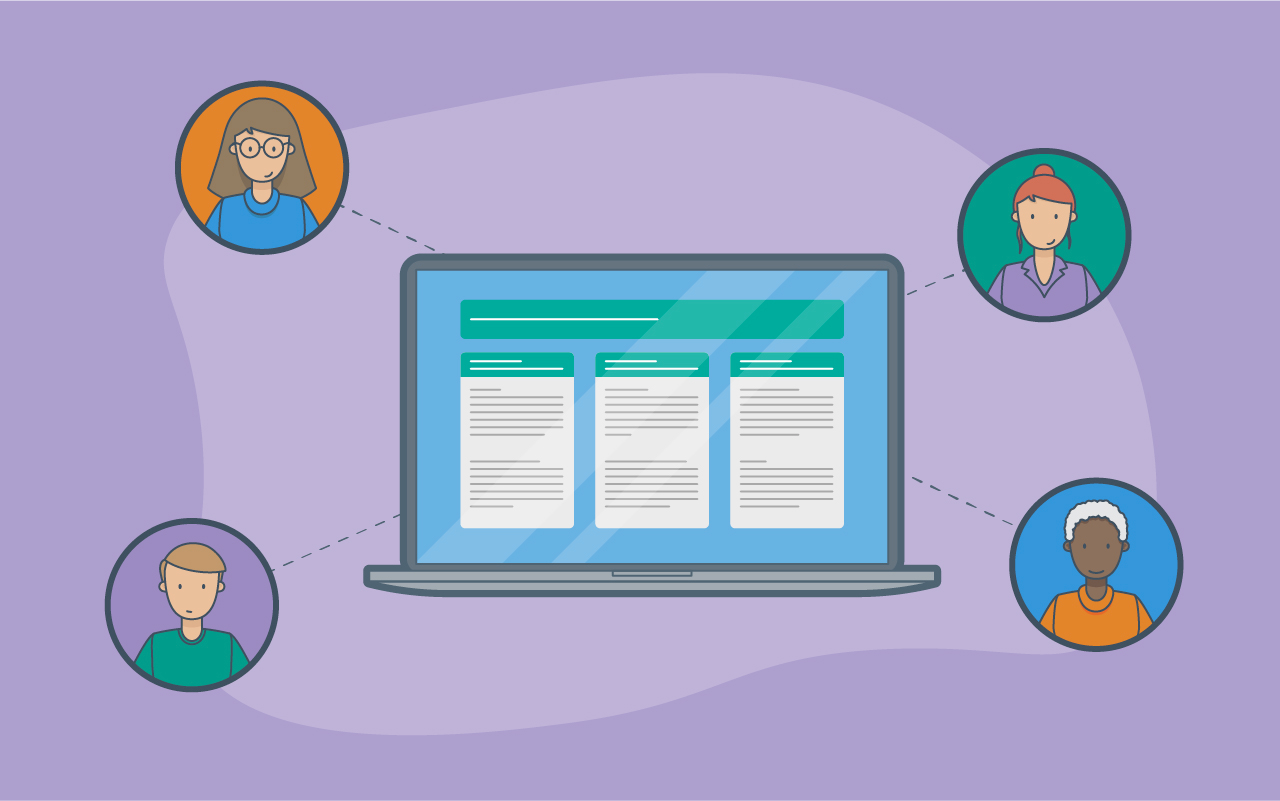Enterprise Service Management, ESM, is rising in popularity as organizations look to streamline processes. ESM promises to help organize and coordinate a variety of business units in a time when remote and hybrid work are challenging the way different teams communicate. But with interest in ESM so high, it’s important to gauge ESM capabilities and create an effective strategy for implementation.
In this post, we will discuss:
- What is Enterprise Service Management?
- What’s the Difference Between ITSM and ESM?
- Who Can Benefit from Using ESM?
- What are the Trends in ESM Adoption
- How does ITIL Apply to ESM?
- What are the Benefits of ESM?
- 5 ESM Best Practices
- How to Get Started with ESM Software: Is ESM Right for Your Enterprise?
What is Enterprise Service Management (ESM)?
Enterprise Service Management is an evolution of ITSM which aims to provide different business units in an enterprise with the same functionality that ITSM provides the IT service desk. ESM works to help different departments across the enterprise communicate and operate with shared goals and a standard set of procedures. The goal of ESM is to give an enterprise the ability to deliver support services for employees.
In other words, ESM is the evolution of taking service management beyond IT.
Think of a business as a train and train track. The company has the same overall goal – to get from point A to point B. But, one team is building the tracks while another team is driving the train, simultaneously relying on a third team to shovel the coal into the engine. ESM is the device that helps the team on the track communicate with the conductor and the engine teams. In this way, the teams keep driving the train forward and minimize friction or problems from a lack of uniform communication.
What’s the Difference Between ITSM and ESM?
With the definition of ESM in mind, you might be thinking “Shouldn’t that mean that ITSM and ESM are the same thing? Can I use my ITSM tool for ESM purposes?”
While that thinking is not wrong (you can use your ITSM tool for ESM purposes), it’s important to understand that as ESM has evolved, it has become somewhat separate from ITSM. In other words, not all ITSM tools can be used for ESM.
In fact, according to Gartner “By 2022, more than 90% of I&O leaders who selected a new ITSM tool in 2018 because of its promoted capabilities beyond ITSM will remain below ITScore for I&O Level 3.”1
So what’s the difference? There are a few key differences to understand. ITSM is specific to the IT department including the service or help desk and there are specific procedures relating to IT processes. Enterprise Service Management is used across many departments. For example, ESM can be used for Human Resources (HR) requests, building Facilities requests, and employee onboarding.
An ESM tool should have capabilities built in to expand and support functions and business units beyond IT. These might include self-service capabilities, automated ticketing, and a variety of processes. Furthermore, you can use some of the same ITIL processes for ESM functionality, which we will discuss later in the post.

Who Can Benefit from Using ESM?
Businesses of a variety of sizes can benefit from using ESM software. However, mid-sized to larger organizations will likely see the biggest return on their investment in an ESM tool.
Within an enterprise, business units who provide a service to other teams can benefit from ESM. A few examples of these units include:
- Human Resources (HR): Employees need to contact HR for a variety of reasons, from benefits enrollment and payroll to requests and complaints. Traditionally, this might have meant that the HR team is fielding calls and emails, but this method relies heavily on the HR team being able to communicate and coordinate to make sure they have resolved the issue for the employee without doing double work. However, with ESM, employees can submit tickets for requests, utilize a self-service platform in order to access knowledge articles, and track the progress of existing requests. This can be especially helpful with things like extended time off, family leave, and other requests that might need multiple layers of approval. This gives HR representatives better organization and insight into which requests might need a follow up and gives them the ability to handle more high-level problems.
- Facilities: Whether your company has a number of facilities spread across a vast geographic region or you are located in one office space, ESM can help facilitate building requests. For example, if a chain of stores needs help replacing or repairing lighting, or addressing building issues, a ticket can be created and tracked using ESM, then automatically routed to the correct party for resolution. This might mean routing the ticket to maintenance personnel or contractors.
- Marketing: Marketing departments are often responsible for creating collateral for various departments or localizing marketing information for different regions. However, sending emails or phone calls to the marketing department can sometimes result in the wrong person getting the request. ESM software can help guide employees to collateral they can use via a self-service portal and can facilitate ticket creation so that the proper party is notified of what is needed and the team can work through it without losing track of the request.
You can learn about additional uses for ESM in our infographic, including uses for new-hire onboarding, legal, and office management.
ESM Adoption: What are the Trends in ESM Adoption?
ESM has been called a “new old trend” because it seems to grow in waves. In a recent survey conducted by AXELOS and ITSM.tools, two-thirds of organizations (67.6%) currently have enterprise service management strategies in use. Over half of these organizations (37.5% of the total orgs surveyed), were considered to be well advanced with their enterprise management strategy – this is up from just 7% in 2019. Further, only 11% of organizations responded as having no plans for enterprise service management in the future.
For many companies, ESM began with expanding ITSM outside of IT. Studies from Forrester have shown that 50% of the workload handled by a given ITSM ticketing system is not related to IT, thereby falling under the category of ESM.2
How does ITIL Apply to ESM?
Since ESM is an evolution of ITSM, you might find yourself wondering how ITIL fits into the puzzle. While some ITIL processes and practices are specific to IT, there are others that you might find helpful for other departments including:
- Change management (now called Change Enablement in ITIL 4)
- Incident Management
- Service Request Management
- Asset Management
- Problem Management
- Knowledge Management
- Service Catalog Management
Of course, there are other processes in ITIL that can be used in ESM, but for the most part companies seem to be relying on the ability to manage tickets, incidents, changes, and tickets.
What are the Benefits of Enterprise Service Management?
Similar to ITSM, the benefits of ESM extend to both employees and customers. In fact, organizations which reported expanding ITSM practices and software beyond IT saw a 52% increase in employee satisfaction and a 75% increase in productivity.3
Other benefits of ESM include:
Improved efficiency and reduced operational costs
According to a recent research study from IDC, 63% of organizations have shifted and/or increased technology spending towards recalibration and reignition. Yet the same report identified that only 26% of organizations can demonstrate meaningful returns on digital transformation investments. But what does that mean for ESM? It means that by utilizing service management departments who have new technology and are undergoing digital transformation can still communicate clearly. This translates to reduced operational costs, with the added benefit of asset tracking and information that can help a variety of departments who are looking to reduce costs. With the uniform procedures of Enterprise Service Management, companies can see a decrease in costs by as much as 50% and in increase in productivity by 30%.
Better ROI on Existing ITSM Technology
Chances are that your IT service desk is already utilizing a service management software. Through using an appropriate ITSM tool for ESM purposes, you can get a better ROI on software you may already have in use within the IT service desk. Self-service integrations within ESM can help ensure you have a better ROI on knowledge management as well. The better ROI comes directly from the expanded use of the software.
Improved Cross-Departmental Communication and Service Delivery
Various departments across the enterprise have different methods of communication. This can become confusing when these units must interact. Uniform ways to communicate help to create a more cohesive environment. An ESM tool provides collaborative support in a uniform way, whether the teams are remote or in person. This can lead to overall smoother interactions and better employee experiences.
Greater Self-Service Capabilities
The different types of self-service capabilities, including the ability to search for and submit HR requests, facilities requests, marketing requests, or any other need, work together to increase the use of the ESM tool and boost productivity. Just as ESM maximizes the ROI on a corporate ITSM tool, self-service boosts the ROI of an ITSM or ESM tool. To fully calculate the ROI of self-service technology with service management, request an in-depth calculation here.

Streamlined Knowledge Sharing and Standardization
An ESM tool paired with an intelligent knowledge management system leads to a more standardized way of storing and sharing knowledge. This is especially helpful for employees who might move to a new department in the same company, or for managers who oversee multiple teams.
Better Customer Experience
All of the above benefits compound into a better customer experience. ESM software helps facilitate and coordinate departments for faster resolution of needs, whether they are from HR, facilities, legal, marketing, sales, or any other business unit. When employees are satisfied, it pushes them to provide a better experience to their customers. This ripple effect is good for the whole business.
5 Enterprise Service Management Best Practices
Enterprise Service Management has a few best practices to help you succeed. The list below is not exhaustive but are a few important factors in ESM success.
Best Practice 1: Define ESM Goals
Perhaps the most important best practice when implementing or using any ESM solution is to create a clear strategy and define the goals of the software. Know your goals for each department that will be using ESM to facilitate cross-departmental needs. Are the goals to increase visibility? Create clear guidelines for requests? Think about these goals and define the journey for each business unit that will use the software.
Best Practice 2: Communicate with Customers and Employees
In order to get teams on board with using a new tool like ESM, you have to communicate properly to increase adoption. You must market the tool properly internally, which might mean sending email communication, newsletters, or other literature to teams to help them understand the benefits. Then, moving forward, if customers use old methods of communication, remind them of the ESM software in place to increase their likelihood of adoption.
Best Practice 3: Create a Multiexperience Platform
Meet customers where they are with multiexperience apps for ticket creation and processing. Multiexperience apps, an evolution of multichannel or omnichannel, give customers the ability to submit tickets and locate information with a unique experience to whichever device they prefer. If they are using wearable tech like a smart watch or prefer their smart phone to their laptop or tablet, the app will still be functioning and simple. You can learn more about multiexperience in this blog post.
Best Practice 4: Integrate Self-Service
We mentioned multiexperience, which is a type of self-service platform. But it is important to set up a self-service portal in general for your ESM tool. Self-service should incorporate the service management piece along with knowledge management. This will combine things like ticket creation with the ability to locate your own answers. Overall, this will allow customers of any department to attempt to solve their own problems before speaking to a human, which can cut down on the amount of redundant work. For example, finding the information you need in a self-service portal about your HR forms can free up the team in the HR department to solve bigger issues, like leave requests or employee complaints.
Best Practice 5: Utilize Automation
Automation in ESM can make a good team great. This might mean utilizing automated workflows in the ESM software or creating automated ticketing and request management systems. It might also mean utilizing AI technology like a chatbot for self-service needs and knowledge management. Automation, when used correctly, can magnify an efficient organization, reduce onboarding time, and create a more seamless user experience.
How to Get Started with ESM Software: Is ESM Right for Your Enterprise?
The first step in getting started with ESM is to gauge whether your teams will benefit from an ESM tool. Before you get started, download our pre-launch checklist for a starting point. This checklist includes asking yourself:
- Is my department internally facing?
- Would my department benefit from workflow automation?
- Does my department have existing processes in place to meet business demands?
- Is my current method of communicating with customers efficient?
- Will my team benefit from automated service delivery?
Once you’ve reviewed the pre-launch checklist, look at your current ITSM tool and find out if it is right for broader, beyond IT, ESM use. Remember, not all ITSM tools can be used for ESM purposes. You will need to make sure that the tool you decide to use will be able to scale with your organization, otherwise you’ll be looking at replacing software as you grow – which is often the time that big changes are the most stressful.
Utilizing ESM, you can bring teams together to create a more cohesive experience for employees, and by proxy, customers. But it is important to create an ESM strategy that matches your business goals.
You can learn more about taking ITSM beyond IT and utilizing ESM by speaking with an EasyVista expert.
1 Gartner, The Reality of ITSM Tools as Enterprise Service Management Tools, Chris Matchett, Daniel Stand, et al. 6 December 2019
2 Forrester, Enterprise Service Management Drives Engagement, Charles Betz, 2 August, 2017
3 HDI, The State of Enterprise Service Management


